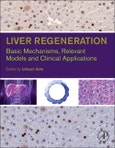Liver Regeneration: Basic Mechanisms, Relevant Models and Clinical Applications presents cutting-edge information on liver regeneration research through an integrated, systems-wide perspective. The book addresses discoveries on hepatic progenitor cells, liver regeneration after chemical damage, and liver regeneration as a prime therapy for liver failure and disease.
By addressing the urgent need for translating basic research findings into clinically relevant modalities and potential therapeutic applications, the book provides the data needed to improve liver patient management.
Hundreds of full-color, graphic photographs and illustrations underline key elements and show researchers and students important aspects of liver transplantation, immunofluorescence, and other techniques used in liver regeneration.
Please Note: This is an On Demand product, delivery may take up to 11 working days after payment has been received.
By addressing the urgent need for translating basic research findings into clinically relevant modalities and potential therapeutic applications, the book provides the data needed to improve liver patient management.
Hundreds of full-color, graphic photographs and illustrations underline key elements and show researchers and students important aspects of liver transplantation, immunofluorescence, and other techniques used in liver regeneration.
Please Note: This is an On Demand product, delivery may take up to 11 working days after payment has been received.
Table of Contents
Chapter 1. Introduction to Liver Regeneration: History and General PrinciplesChapter 2. Models to Study Liver Regeneration
Chapter 3. Alternative Models to Study Liver Regeneration: Zebrafish
Chapter 4. The Priming and Progression Theory of Liver Regeneration
Chapter 5. Primary and Secondary Mitogen Theory of Liver Regeneration
Chapter 6. Developmental Pathways in Liver Regeneration
Chapter 7. Mechanisms of Termination of Liver Regeneration
Chapter 8. Modulation of Extracellular Matrix During Liver Regeneration
Chapter 9. Role of Chemokines
Chapter 10. Role of Nuclear Receptors
Chapter 11. Role of Developmental Morphogens in Liver Regeneration
Chapter 12. Regulation of Cell Cycle during Liver Regeneration
Chapter 13. Role of microRNAs and Long Non-Coding RNAs in Liver Regeneration
Chapter 14. Changes in Hepatocyte Ploidy during Liver Regeneration
Chapter 15. Role of Endothelial Cells in Liver Regeneration
Chapter 16. Use of Computational Biology, Omics Technologies to Understand Liver Regeneration
Chapter 17. Mitogen Induced Cell Proliferation in the Liver
Chapter 18. Effect of Nutritional Diversity on Liver Regeneration
Chapter 19. Introduction of Hepatic Progenitor Cells
Chapter 20. Cellular Transdifferentiation in the Liver
Chapter 21. Activation of Hepatic Progenitor Cells in Liver Regeneration After Chemical Injury to the Liver
Chapter 22. Hepatic Progenitor Cells and iPS Cells as a Source of Mature Hepatocytes
Chapter 23. Progenitor Cell Transplantation: Experimental Models
Chapter 24. Liver Regeneration as a Therapy for Acute Liver Failure
Chapter 25. Liver Regeneration Following Liver Transplantation
Chapter 26. Hepatocyte Transplantation Therapy
Chapter 27. Liver Regeneration: The Biliary Perspective








